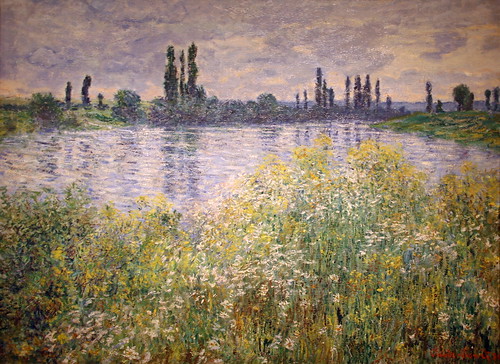
Outside the Box
Saturday, September 24, 2011
A Feeling From the Past

Wednesday, September 21, 2011
The Beautiful Seine

The name of the painting is "Banks of the Seine, Vetheuil". The Seine is a main river that flows within France. It has been the subject of numerous works of art. The painting in itself is very serene. It is the classic outcome of the artist archetype. The calm river could signify peace and tranquility or rebirth. What do you think? The river winds around a bend in the far distance. This represents the seeker and pioneer archetype. What do you think is around the bend? The archetype of the seer is also prevalent in this painting. Monet saw something so simple and ordinary and trapped it on canvas. Monet captured life using the nature archetype in this painting. The luscious wild flowers are in bloom everywhere. They are healthy and strong and consume the painting. It was almost as if Monet wanted to will you to slow down, even if just for a minute, and enjoy nature. What do you think this painting represents?
sources:http://www.lucidcafe.com/library/95nov/monet.html
http://www.artquotes.net/masters/monet-biography.htm
http://www.famouspainter.com/claude.htm
The Hay Wain by John Constable

This scene is incredibly peaceful and quiet, and I think that is what he wanted to portray. Country life is simple, and Constable knew this. He drew and painted the surroundings that were familiar to him. If you haven’t been to Suffolk, England lately, you might be wondering what it looks like in that area. Well, I think this painting gives you a pretty good idea of how beautiful it actually is. If I could sum up my thoughts on this painting in one word, it would be “serene.”
Leonardo da Vinci's The Last Supper
Considerably one of Leonardo da Vinci's most famous pieces, The Last Supper depicts the meal that Jesus shared with His disciples prior to His crucifixion. By request of Leonardo's patron, the mural was painted in the 15th century in Milan, Italy as a centerpiece for a mausoleum that was being built for the Sforza family. While most of Leonardo's paintings portray a strong influence from the Renaissance style of art, Leonardo was influenced by various styles of art.
At the age of fourteen Leonardo began his career in art, working alongside notable artists from the time. His work was not limited to painting, though. Leonardo immersed himself in various mediums ranging from sculpting to metalworking that allowed him to use his vast knowledge of those mediums to create art in unique ways. In 1519 Leonardo died, leaving behind a legacy that so prominently intertwines itself in the modern world of art.
Being the religious nut that I am, I find it amazing how in one painting Leonardo was able to capture the entire essence of the Last Supper and the utter horror of the disciples when they find that amongst them is the man who will essentially crucify their Lord and Savior. On each one of the Apostle's faces you can clearly see the agony, yet Christ's peaceful expression remains unchanged. A mural of this size, having the detail that it does, truly makes it a magnificent piece of work.